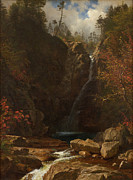Zimmerli Art Museum at Rutgers University

Glen Ellis Falls , Albert Bierstadt
Fine Art Prints | Greeting Cards | Phone Cases | Lifestyle | Face Masks | Men's , Women' Apparel | Home Decor | jigsaw puzzles | Notebooks | Tapestries | ...
The Zimmerli Art Museum is located on the Voorhees Mall of the campus of Rutgers University in New Brunswick, New Jersey. The museum houses more than 60,000 works, including Russian and Soviet Nonconformist Art from the acclaimed Dodge Collection, American art from the 18th century to the present, and six centuries of European art with a particular focus on 19th-century French art. The Zimmerli is also noted for its holdings of works on paper, including prints, drawings, photographs, original illustrations for children's books, and rare books.
Description
The Zimmerli Art Museum was founded in 1966 as the Rutgers University Art Gallery to celebrate the university’s bicentennial. The gallery was expanded in 1983 and renamed the Jane Voorhees Zimmerli Art Museum in honor of the mother of Ralph and Alan Voorhees, the major benefactors for the museum’s expansion.
The Zimmerli occupies a 70,000-square-foot facility, which is located on the New Brunswick campus of Rutgers, The State University of New Jersey.
The museum’s permanent collection totals more than 60,000 works in a wide range of media and includes a survey of Western art from the 15th century to the present. The Zimmerli has holdings in:
19th-century French art, particularly prints and rare books
Russian art and Soviet nonconformist art from the Dodge Collection
American art, especially prints
Selections from these holdings, along with focused presentations of European art, art inspired by Japan (called Japonisme), ancient Greek and Roman art, Pre-Columbian art, and American illustrations for children’s books, are always on view at the Zimmerli. The museum also makes these holding available through an active program of loans to art museums nationally and internationally, as well as and through participation in The Google Art Project and ARTstor.
Programs and exhibitions
The Zimmerli presents exhibitions as a teaching museum with an interdisciplinary perspective. The museum is now free for all visitors and offers tours for groups. The Zimmerli also houses a café.
As a teaching museum, the Zimmerli contributes to the academic programs of undergraduate and graduate students at Rutgers, and also offers programs to the broader community. Rutgers faculty from both the humanities and the sciences use the museum for their classes to stimulate interdisciplinary inquiry among undergraduate and graduate students from all areas of study. The Zimmerli collaborates with the university’s Department of Art History in its curatorial training programs, as well as through its endowed fellowships and internships for graduate students seeking careers in the museum field. Elementary and secondary students enjoy interactive tours designed for their age groups and academic requirements. Teachers of K-12 students benefit from workshops that the Zimmerli organizes in collaboration with the Rutgers Graduate School of Education and satisfy mandated professional development requirements. In addition, the museum offers drawing workshops for all ages, as well as storytelling for preschoolers and day trips for adults who wish to learn more about specific aspects of art.
Permanent collection
American art
The Zimmerli Art Museum’s American art collection numbers more than 16,500 objects. It includes paintings, sculpture, works on paper (prints, drawings, and photographs), and decorative arts. The earliest paintings in the Zimmerli’s collection date to the late 18th century, when the United States and Rutgers University – then called Queen’s College – were in their infancy. Reflecting America’s rich artistic and cultural heritage, the museum showcases examples of portraiture, landscape, still life, narrative art, and abstraction. Modern and contemporary styles represented in the collection include precisionism, surrealism, abstract expressionism, geometric abstraction, pop and op art, Fluxus, photo-realism, and minimalism, as well as works that explore social and political issues. Work by women artists is a distinguishing aspect of the Zimmerli’s American holdings and signals Rutgers’ pioneering role in women’s studies.
American Art Gallery
European art
The Zimmerli’s collection of European art comprises paintings, sculpture, works on paper, rare books, and decorative arts, and ranges in date from the Renaissance to the present, totaling close to 10,000 objects, with its primary strength in French 19th-century works on paper, notably prints and rare books. Strongly represented subjects include portraits and caricatures, landscapes, and popular entertainments. Also among the European holdings is a renowned collection of Japonisme, late-19th-century works by European artists inspired by Japanese art and aesthetics.
European Art Gallery
Russian art and Soviet nonconformist art
The Zimmerli’s Russian and Soviet nonconformist art holdings contain some 22,000 objects and provide an overview of art in Russia from the 14th century to the present. The Imperial era of Russian art is represented through George Riabov’s 1990 donation, which spans styles and subjects that represent Russia’s diverse artistic heritage, genres, and visual cultures.
The Dodge Collection is the largest collection of Soviet Nonconformist Art in existence.[1] The collection was amassed by an economics professor from the University of Maryland, Norton Dodge, from the late 1950s until the advent of Perestroika.[2] It was gift of Norton and Nancy Dodge in 1991. More than 20,000 works by close to 1,000 artists reveal a culture that defied the politically imposed conventions of Socialist Realism. All media are represented, including paintings on canvas and panel, sculpture, assemblage, decorative objects, installations, works on paper, photography, video, artists’ books and self-published texts called samizdat. This encyclopedic array of nonconformist art extends from about 1956 to 1986, from the beginning of Khrushchev’s cultural “thaw” to the advent of Gorbachev’s glasnost and perestroika. Work created during the Gorbachev era (through 1991) is also represented. The collection includes art made in Russia, as well as many examples of nonconformist art produced in the Soviet republics: Armenia, Azerbaijan, Belarus, Estonia, Georgia, Kazakhstan, Kyrgyzstan, Latvia, Lithuania, Turkmenistan, Ukraine, and Uzbekistan. A recent gift by Claude and Nina Gruen extends the Zimmerli Russian art holdings to post-Perestroika work produced since 1986. Many of these artworks were made by former Soviet artists now living in the diaspora. In addition, the Zimmerli has seven archives associated with Soviet nonconformist art. Collectively, these archives include more than 50,000 items.
References
http://www.zimmerlimuseum.rutgers.edu/russian-art-soviet-nonconformist-art-gallery Russian Art and Soviet Nonconformist Art Gallery
Soviet Art Photography from the 70s and 80s Opens at Rutgers University, Art Daily.
---
Fine Art Prints | Greeting Cards | Phone Cases | Lifestyle | Face Masks | Men's , Women' Apparel | Home Decor | jigsaw puzzles | Notebooks | Tapestries | ...
---
Artist
A - B - C - D - E - F - G - H - I - J - K - L - M -
N - O - P - Q - R - S - T - U - V - W - X - Y - Z
Retrieved from "http://en.wikipedia.org/"
All text is available under the terms of the GNU Free Documentation License



